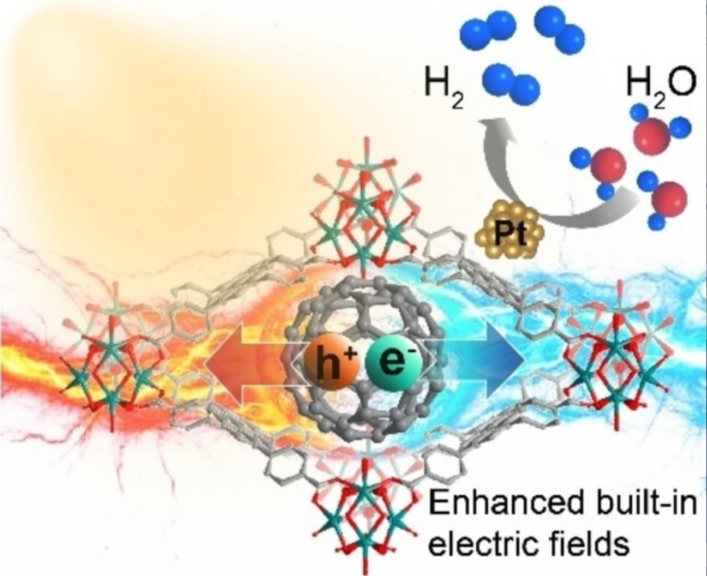Liu, L., Meng, H., Chai, Y., Chen, X., Xu, J., Liu, X., Liu, W., Guldi, D. M., Zhu, Y., Angew. Chem. Int. Ed. 2023, 62, e202217897. https://doi.org/10.1002/anie.202217897
High-efficiency photocatalysts based on metal-organic frameworks (MOFs) are often limited by poor charge separation and slow charge-transfer kinetics. Herein, a novel MOF photocatalyst is successfully constructed by encapsulating C60 into a nano-sized zirconium-based MOF, NU-901. By virtue of host-guest interactions and uneven charge distribution, a substantial electrostatic potential difference is set-up in C60@NU-901. The direct consequence is a robust built-in electric field, which tends to be 10.7 times higher in C60@NU-901 than that found in NU-901. In the catalyst, photogenerated charge carriers are efficiently separated and transported to the surface. For example, photocatalytic hydrogen evolution reaches 22.3 mmol g−1 h−1 for C60@NU-901, which is among the highest values for MOFs. Our concept of enhancing charge separation by harnessing host-guest interactions constitutes a promising strategy to design photocatalysts for efficient solar-to-chemical energy conversion.

Liu, L., Meng, H., Chai, Y., Chen, X., Xu, J., Liu, X., Liu, W., Guldi, D. M., Zhu, Y., Angew. Chem. Int. Ed. 2023, 62, e202217897. https://doi.org/10.1002/anie.202217897
High-efficiency photocatalysts based on metal-organic frameworks (MOFs) are often limited by poor charge separation and slow charge-transfer kinetics. Herein, a novel MOF photocatalyst is successfully constructed by encapsulating C60 into a nano-sized zirconium-based MOF, NU-901. By virtue of host-guest interactions and uneven charge distribution, a substantial electrostatic potential difference is set-up in C60@NU-901. The direct consequence is a robust built-in electric field, which tends to be 10.7 times higher in C60@NU-901 than that found in NU-901. In the catalyst, photogenerated charge carriers are efficiently separated and transported to the surface. For example, photocatalytic hydrogen evolution reaches 22.3 mmol g−1 h−1 for C60@NU-901, which is among the highest values for MOFs. Our concept of enhancing charge separation by harnessing host-guest interactions constitutes a promising strategy to design photocatalysts for efficient solar-to-chemical energy conversion.